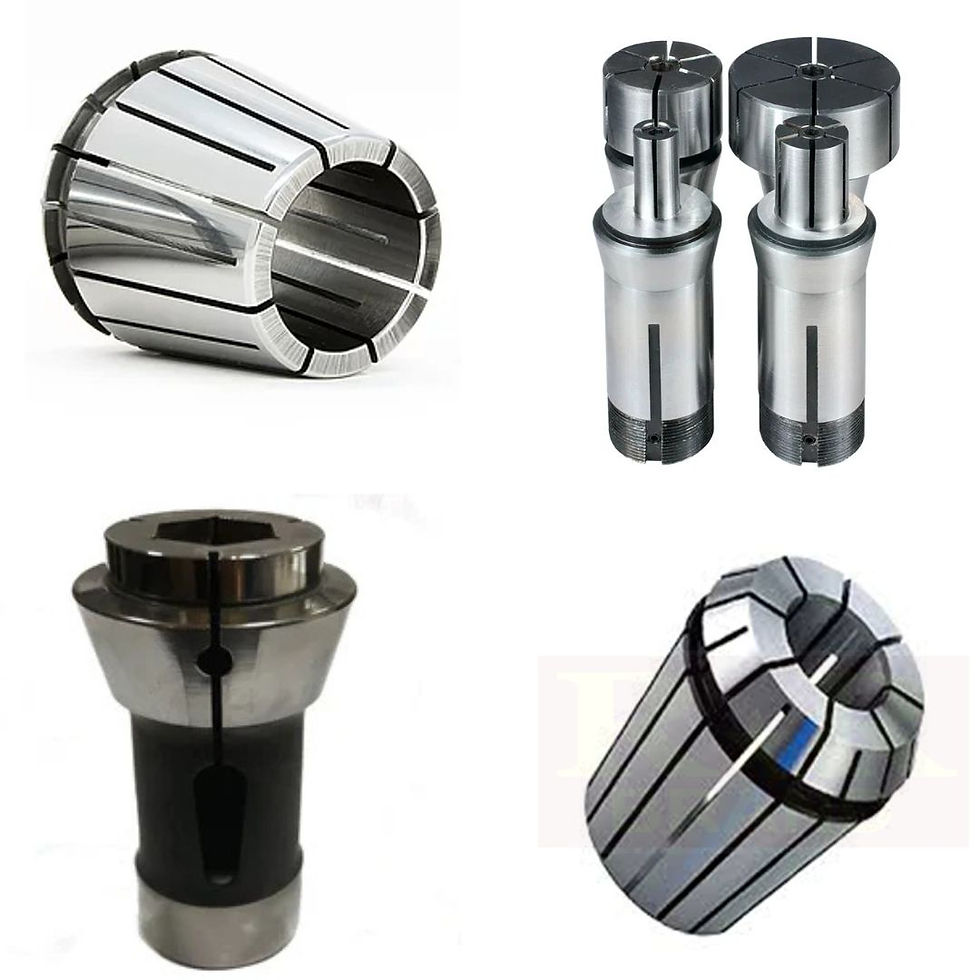How to Select the Right ER Collet Size for Your Tool Holder
- nazmakhatoon1057
- Jul 26
- 3 min read
When it comes to precision machining, using the right tool holding system is critical to achieving optimal performance, minimizing tool runout, and ensuring safety.

Most popular and versatile systems are ER collets, which offer a flexible clamping range and are compatible with various tool holders.
Selecting the correct ER collet size for your specific application can greatly improve your machining quality and productivity.
This article provides a comprehensive guide on how to choose the right ER collet size for your tool holder, including considerations for different machines, tooling, and materials.
It also covers specialized options like Traub collets, which cater to high-speed turning machines.
What is an ER Collet?
An ER collet is a cylindrical tool-holding device with slits that allow it to collapse and clamp tightly around a tool shank or workpiece.
Designed to be used in conjunction with a collet chuck and a clamping nut, ER collets are known for their reliability, excellent concentricity, and ability to hold a range of diameters within a single collet size.
ER collets are commonly used in:
CNC milling machines
Turning centers
Drilling machines
Tapping machines
Traub machines and sliding head automats
ER Collet Sizes and Their Range
ER collets are standardized and come in a variety of sizes such as ER8, ER11, ER16, ER20, ER25, ER32, ER40, and ER50. Each size corresponds to a range of tool diameters it can grip. For instance:
ER16 collet: holds tool shanks from 1mm to 10mm
ER32 collet: grips tools between 2mm and 20mm
ER40 collet: handles larger tools up to 26mm
The gripping range for each collet size usually spans 1mm, and collets are available in 0.5mm or 1mm increments for better precision.
Key Factors to Consider When Selecting ER Collet Size
1. Tool Shank Diameter
The most important factor in choosing the right ER collet size is the diameter of the tool shank or workpiece.
Always select a collet size that closely matches the tool diameter. For example, if your tool shank is 10mm, an ER16-10 collet would be suitable.
While ER collets can clamp a range of sizes, choosing the exact or closest matching size ensures better gripping force and concentricity.
2. Type of Operation
Consider the machining process being performed. For high-speed milling, choose smaller collets like ER16 or ER20 for reduced weight and better balance.
For heavy-duty roughing or large-diameter drilling, opt for larger sizes like ER32 or ER40 for higher clamping force.
3. Machine Tool Compatibility
Not all tool holders are compatible with all ER collet sizes. Verify your spindle or turret’s interface and select collet chucks that match.
For example, Traub collets are designed specifically for Traub sliding head machines and might have unique geometry compared to standard ER collets.
4. Collet Chuck Size
Your tool holder will dictate the maximum ER collet size you can use. A tool holder designed for ER32 collets cannot accommodate an ER40 collet, so always match the collet size to the chuck.
5. Clamping Range vs. Precision Needs
If your machining requires high precision and low runout, choose a collet that matches the tool size exactly.
Avoid using the extreme limits of the collet’s range, as this can lead to reduced accuracy and tool slippage.
Traub Collets: A Special Mention
Traub collets are a specific type of collet used in Traub-style automatic lathes and sliding headstock machines.
While ER collets are more general-purpose, Traub collets are optimized for high-speed turning and automated part production.
In high-volume environments like those found in Roorkee’s manufacturing units, Traub collets are often preferred for their quick changeover capabilities and robust clamping.
Best Practices for ER Collet Selection and Use
Clean Before Use: Ensure the collet and tool shank are free of debris to prevent runout.
Use the Right Nut and Torque: Always use the correct ER collet nut and tighten it to the recommended torque.
Avoid Over-Clamping: Don’t exceed the clamping range of the collet to avoid damage.
Inspect for Wear: Regularly check your collets for cracks, corrosion, or deformation.
Conclusion
Choosing the right ER collet size is not just about matching numbers—it's about understanding the requirements of your tool, your machining operation, and your equipment.
Using standard ER collets or specialized solutions like Traub collets, proper selection ensures greater accuracy, tool life, and operational efficiency.
By following the guidelines above and working with reliable suppliers, machinists can make informed decisions that enhance productivity and machining precision.

Comments